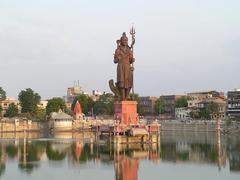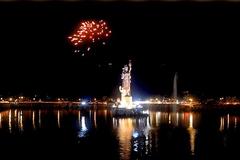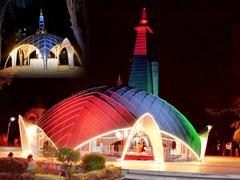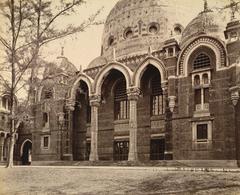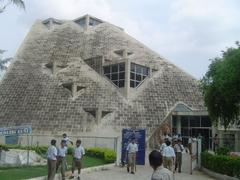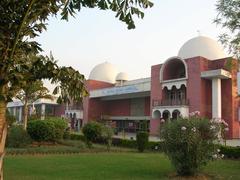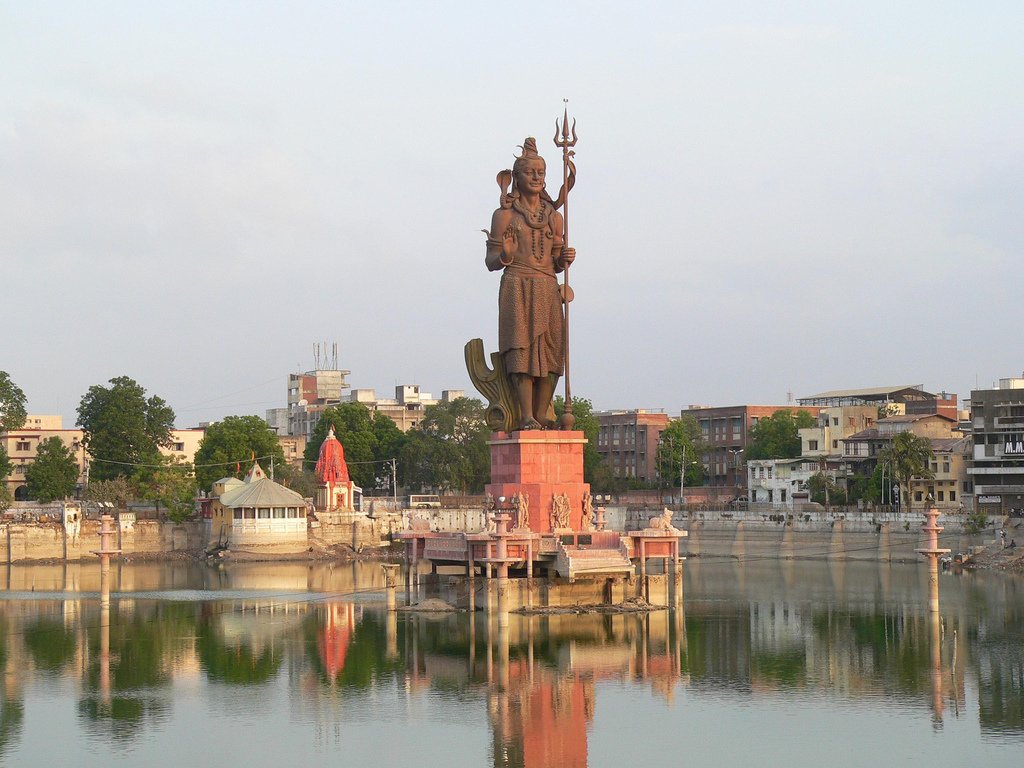
Shiva Statue Vadodara: Visiting Hours, Tickets, and Tips
Date: 25/07/2024
Introduction
Sursagar Lake, also known as Chand Talao, is a historic and cultural landmark in Vadodara, Gujarat, India. The lake, reconstructed in the 18th century, is now home to the iconic Shiva Statue, which has become a significant tourist attraction and a symbol of religious devotion. This comprehensive guide aims to provide visitors with all the necessary information for an enriching experience, covering the lake’s history, visitor details, cultural significance, and practical travel tips.
The Shiva Statue, known locally as Sarveshwar Mahadev, stands at an impressive height of 111 feet and is located in the middle of Sursagar Lake. Its construction began in 1996 and was completed in 2002 as part of a beautification project by the Vadodara Municipal Corporation (Wikipedia). Recently, the statue underwent a significant transformation with the addition of 17.5 kg of gold plating, further enhancing its aesthetic and spiritual appeal (News9Live).
Sursagar Lake itself has a rich history, initially serving as a pivotal feature in the old walled city of Kila-e-Dulatabad. It was extended in the 1750s by Sureshwar Desai, leading to its current name, Sursagar (History of Vadodara). Over the years, significant urban renewal efforts have been made to maintain and enhance the lake, including the construction of retaining walls and underground gates to manage water levels and prevent flooding. Today, the lake and its iconic Shiva Statue are a testament to Vadodara’s rich cultural heritage and ongoing urban development.
Table of Contents
- Introduction
- History of the Shiva Statue at Sursagar Lake
- Visitor Information
- Cultural and Religious Significance
- Renovation and Modern Enhancements
- Safety and Environmental Measures
- Challenges and Controversies
- Recent Developments
- Nearby Attractions
- FAQs
- Conclusion
History of the Shiva Statue at Sursagar Lake
Origins and Early Developments
Sursagar Lake, initially known as Chandan Talav, was a pivotal feature in the old walled city of Kila-e-Dulatabad. Reconstructed with stone masonry in the 18th century, the lake was extended in the 1750s by Sureshwar Desai, a Mughal-era tax collector, which led to its current name, Sursagar (History of Vadodara).
Urban Renewal and Infrastructure
Significant urban renewal efforts were undertaken between 1870 and 1875 during the reign of Malharrao Gaekwad. Retaining walls and ‘ghats’ were constructed to manage water levels and prevent flooding. Underground gates were also built to direct excess water to the Vishwamitri River, ensuring Sursagar Lake served as the primary source of drinking water for Vadodara (History of Vadodara).
The Construction of the Shiva Statue
Part of a broader beautification project by the Vadodara Municipal Corporation, the construction of the Shiva Statue began in 1996 and was completed in 2002. Standing at an impressive height of 111 feet (34 meters), this statue is a significant landmark in Vadodara (Wikipedia).
Visitor Information
Visiting Hours and Tickets
The Shiva Statue at Sursagar Lake is accessible to the public at all times, making it an ideal spot for both day and night visits. There are no entry fees to view the statue, allowing everyone to experience its grandeur.
Travel Tips and Accessibility
Sursagar Lake is centrally located, making it easily accessible by various modes of transportation. For international visitors, the nearest airport is Vadodara Airport (BDQ), approximately 8 kilometers away. Local public transport, including buses and auto-rickshaws, can take you directly to the lake.
Cultural and Religious Significance
Festivals and Events
The Shiva statue, known as Sarveshwar Mahadev, is especially significant during festivals like Maha Shivratri, when it is illuminated with lights, attracting devotees and spectators alike. The statue is adorned with 17.5 kg of gold, valued at approximately Rs 12 crore, adding to its cultural and religious importance (History of Vadodara). The statue also becomes a focal point during the Ganesh Festival, where people gather for the immersion of Lord Ganesha idols into the lake’s waters.
Guided Tours and Photography
Guided tours are available, offering detailed insights into the statue’s history and significance. Photography enthusiasts will find numerous picturesque spots around the lake, especially during sunrise and sunset.
Renovation and Modern Enhancements
In 2002, as part of the beautification project, the Vadodara Municipal Corporation renovated the ghats and added a surrounding walkway. Boating activities, previously halted due to safety concerns, have resumed following the remodeling (History of Vadodara).
Safety and Environmental Measures
Sursagar Lake has several gates at the bottom that are opened in case of overflooding, allowing the water to pour into the Vishwamitri River. This infrastructure is crucial for managing the lake’s water levels and preventing flooding in the surrounding areas (Gujarat Tourism).
Challenges and Controversies
Despite its beauty and significance, Sursagar Lake has faced challenges. The lake is known for a large number of suicides, with 15 suicides reported between January and October 2014. Authorities attribute this to the lake’s isolation and seclusion (Wikipedia).
Recent Developments
In 2023, the statue of Lord Shiva was gilded, utilizing about 17.5 kg (39 lb) of gold. The gold-plated statue has now been officially dedicated to the city and its people, further enhancing its cultural and religious significance (Wikipedia).
Nearby Attractions
While visiting Sursagar Lake, consider exploring other nearby attractions such as Laxmi Vilas Palace, Sayaji Baug, and the Maharaja Fateh Singh Museum. These sites offer a deeper dive into Vadodara’s rich history and culture.
FAQs
What are the visiting hours for the Shiva Statue at Sursagar Lake?
The Shiva Statue is accessible to the public at all times.
How much are the tickets for Sursagar Lake?
There are no entry fees to view the Shiva Statue at Sursagar Lake.
What are some travel tips for visiting Vadodara?
Vadodara is well-connected by air, rail, and road. Local transport options such as buses and auto-rickshaws make it easy to get around the city.
Conclusion
The Shiva statue at Sursagar Lake is more than just a monumental structure; it’s a symbol of Vadodara’s rich cultural and religious heritage. Its history, from its origins in the 18th century to its modern-day significance, reflects the city’s evolution. Whether you’re a local or a tourist, a visit to this landmark offers a glimpse into Vadodara’s past and its ongoing journey towards the future. Don’t forget to explore other related posts and follow us on social media for more updates.
For more information on Vadodara’s historical sites and travel tips, check out our other related posts. Make sure to follow us on social media for the latest updates and travel inspiration.
